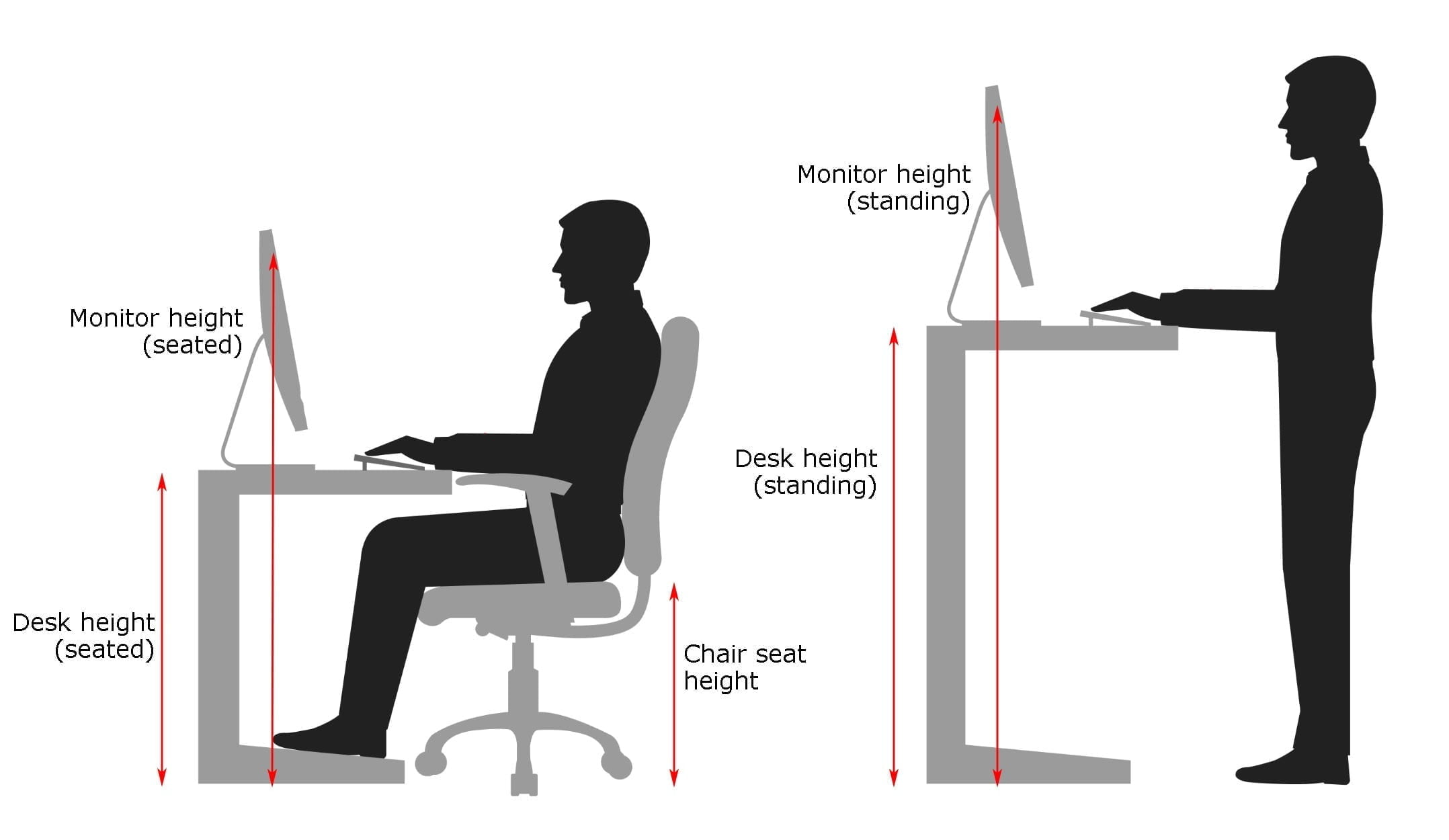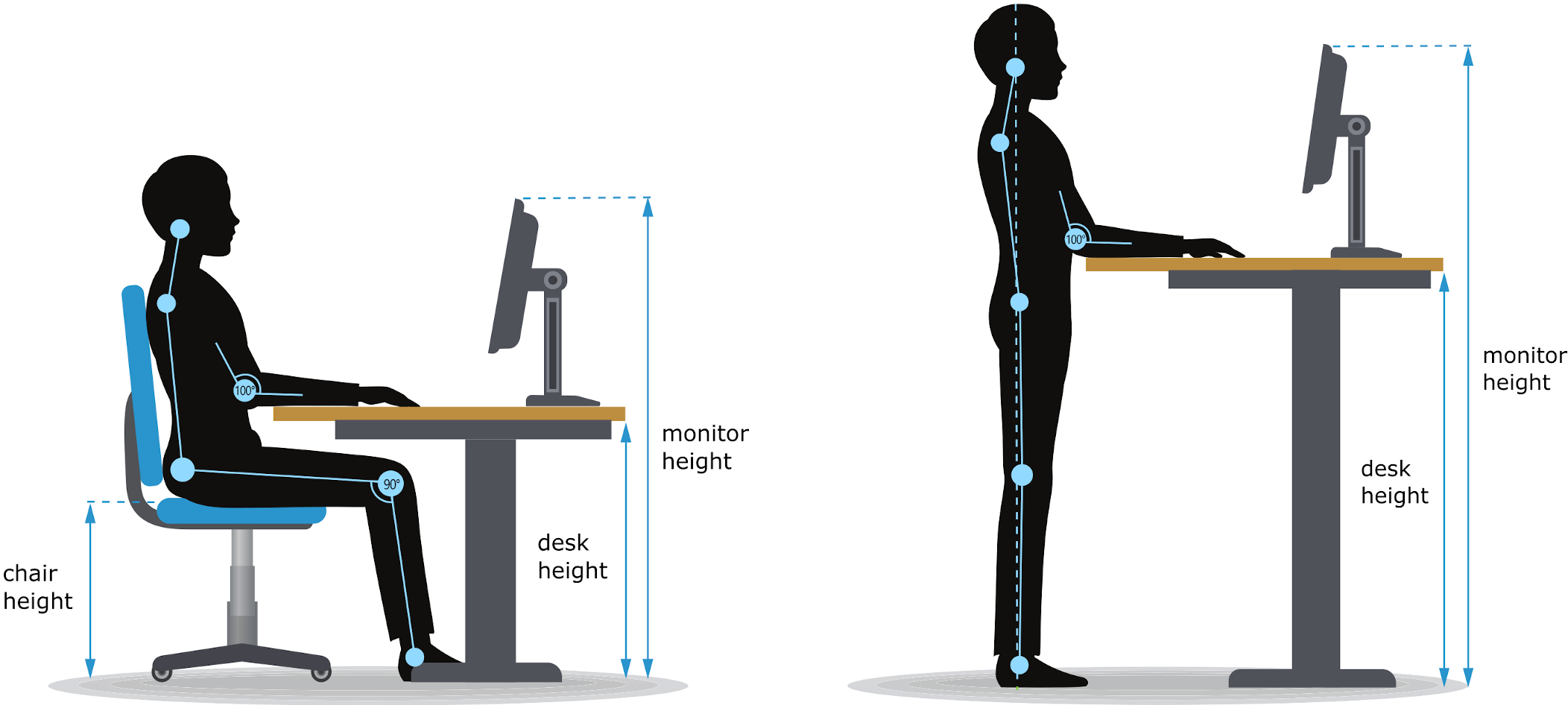Understanding Kneeling Chair Desk Height

Kneeling chairs are designed to promote an upright, ergonomic posture, which can be beneficial for back health and overall comfort. They encourage a more natural sitting position, reducing pressure on the spine and improving blood circulation. This guide explores the ergonomic principles behind kneeling chairs, the benefits they offer, and how to determine the ideal desk height for your setup.
Ergonomic Principles of Kneeling Chairs
Kneeling chairs promote a more natural posture by encouraging a slight forward tilt of the pelvis. This position aligns the spine, reduces strain on the lower back, and promotes proper posture. The design of kneeling chairs also encourages a more active sitting experience, as users engage their core muscles to maintain balance and stability. This active engagement can help improve core strength and reduce muscle fatigue.
Benefits of Kneeling Chairs for Posture and Back Health
- Improved Posture: Kneeling chairs encourage a more upright posture, aligning the spine and reducing strain on the lower back. This can help prevent and alleviate back pain, neck pain, and other musculoskeletal issues.
- Reduced Back Pain: By distributing weight evenly across the hips and thighs, kneeling chairs reduce pressure on the lumbar spine, a common source of back pain. This can be particularly beneficial for individuals who spend long hours sitting.
- Enhanced Blood Circulation: The forward tilt of the pelvis in a kneeling chair improves blood flow to the legs and feet, reducing the risk of varicose veins and other circulatory issues.
- Increased Core Strength: Kneeling chairs engage the core muscles to maintain balance and stability. This can help strengthen the abdominal muscles, improve posture, and reduce back pain.
Ideal Desk Height for a Kneeling Chair Setup
The ideal desk height for a kneeling chair setup depends on the individual’s height, the design of the chair, and personal preferences. A general rule of thumb is to ensure that your elbows are bent at a 90-degree angle when typing or working at the desk. This allows for proper posture and reduces strain on the shoulders and wrists.
- Chair Design: Kneeling chairs come in various designs with adjustable seat heights and knee pads. Some chairs have a fixed height, while others offer adjustable options to customize the fit.
- Body Type: Taller individuals may require a higher desk height than shorter individuals. It’s essential to find a desk height that allows for comfortable posture and a natural arm position.
- Personal Preferences: Some people may prefer a slightly higher or lower desk height depending on their individual needs and comfort levels. Experimenting with different heights can help you find the most suitable setting.
Examples of Kneeling Chair Designs and Height Adjustments
- Adjustable Kneeling Chairs: These chairs offer adjustable seat heights and knee pads, allowing users to customize the fit to their specific needs. For example, the Varier Variable Balans chair features adjustable seat height and knee pad positions, allowing for a personalized experience.
- Fixed Height Kneeling Chairs: These chairs have a fixed seat height and knee pad position, which may not be suitable for everyone. However, they can be a cost-effective option and are often lightweight and portable. The Ergohuman Kneeling Chair is an example of a fixed height kneeling chair.
- Kneeling Chair with Backrest: Some kneeling chairs feature a backrest for added support and comfort. The backrest can help reduce strain on the back and provide additional support for individuals who prefer a more traditional sitting experience. The Humanscale Freedom Kneeling Chair is an example of a kneeling chair with a backrest.
Choosing the Right Kneeling Chair: Kneeling Chair Desk Height

Selecting the perfect kneeling chair involves considering several factors to ensure optimal comfort, support, and functionality. This process involves evaluating various features and understanding your individual needs and preferences.
Knee Pad Materials, Kneeling chair desk height
The knee pads are the crucial contact points with your body, and their material significantly impacts comfort and long-term use.
- Foam Padding: Offers a soft and comfortable feel, providing cushioning and pressure relief. However, foam can compress over time, potentially reducing its effectiveness.
- Gel Padding: Provides superior pressure distribution and support compared to foam. Gel pads conform to your body shape, offering excellent comfort and reducing pressure points.
- Memory Foam: This material molds to your body shape, providing personalized comfort and pressure relief. It also offers good rebound and support, making it a popular choice for kneeling chairs.
Adjustability
Adjustability is essential for finding the right kneeling chair for your body and desk height.
- Height Adjustment: Allows you to customize the chair’s height to match your desk and personal preferences. Look for chairs with a wide range of height adjustment options to ensure a comfortable posture.
- Knee Pad Angle Adjustment: This feature lets you adjust the angle of the knee pads to find the optimal position for your legs and knees. It allows for personalized comfort and reduces strain on your knees.
- Seat Depth Adjustment: Some kneeling chairs offer adjustable seat depth, allowing you to fine-tune the distance between the knee pads and the seat. This customization helps achieve proper leg positioning and comfort.
Stability
Stability is paramount for a safe and comfortable kneeling chair experience. Look for chairs with a wide base and sturdy construction.
- Base Width: A wider base provides greater stability and prevents the chair from tipping over easily.
- Materials: High-quality materials like steel or aluminum contribute to the chair’s overall stability and durability.
- Casters: Choose chairs with smooth-rolling casters that provide easy movement and stability on different floor types.
Factors to Consider
Choosing the right kneeling chair involves assessing your individual needs and preferences.
- Body Size and Weight: Ensure the chair’s weight capacity meets your requirements. Consider the size of the knee pads and seat to ensure adequate support and comfort.
- Desk Height: The chair’s height should complement your desk to achieve an ergonomic posture.
- Intended Use: Consider how often you’ll use the chair and the type of work you’ll be doing. For prolonged use, choose a chair with superior comfort and adjustability features.
Finding the Right Kneeling Chair
Finding the perfect kneeling chair requires a balanced approach between budget, features, and intended use.
- Budget: Kneeling chairs range in price from budget-friendly options to premium models with advanced features. Determine your budget before starting your search.
- Features: Prioritize features that align with your needs and preferences. Consider adjustability, knee pad materials, and stability.
- Intended Use: For occasional use, a basic kneeling chair may suffice. However, for prolonged use or demanding tasks, invest in a chair with enhanced comfort and adjustability features.
Popular Kneeling Chair Brands and Models
Here is a table comparing popular kneeling chair brands and models, highlighting key features and pricing:
| Brand | Model | Features | Price |
|---|---|---|---|
| Varidesk | Pro+ Kneeling Chair | Height adjustable, memory foam knee pads, wide base | $349 |
| ErgoChair | Pro Kneeling Chair | Adjustable knee pad angle, breathable mesh seat, 360-degree swivel | $299 |
| Hbada | Kneeling Chair | Adjustable height, foam knee pads, sturdy construction | $149 |
Setting Up Your Kneeling Chair Desk

Setting up your kneeling chair desk correctly is crucial for maximizing comfort, posture, and overall ergonomic benefits. A well-designed workspace ensures a seamless transition to this unique seating posture, promoting better spinal alignment and reducing pressure on your lower back.
Desk Height and Chair Positioning
The ideal desk height for a kneeling chair should allow your forearms to be parallel to the floor when typing or working on your computer. This ensures a neutral wrist position, minimizing strain and discomfort. The kneeling chair itself should be positioned so that your thighs are parallel to the floor, with your knees slightly lower than your hips. This encourages a natural, upright posture and supports proper spinal alignment.
Footrest Use
Using a footrest with a kneeling chair is essential for maintaining proper posture and blood circulation. It elevates your feet, allowing for a more natural angle in your lower legs and reducing pressure on your knees. Choose a footrest that is adjustable in height and provides a stable platform for your feet. Look for footrests with a textured surface or anti-slip material to prevent slipping.
Adjusting Desk Height and Chair Position
Individual preferences and body measurements play a crucial role in determining the optimal desk height and chair position. Adjusting your desk and chair to suit your specific needs is key to achieving optimal comfort and ergonomics. You can adjust the desk height by using a desk riser or by purchasing a desk specifically designed for kneeling chairs. For the chair, experiment with different knee pad positions and angles to find the most comfortable position for your body.